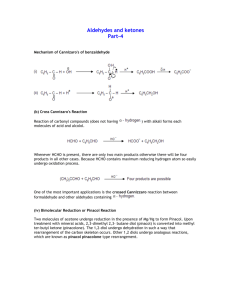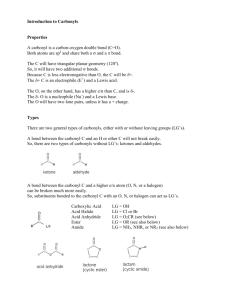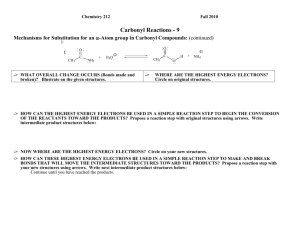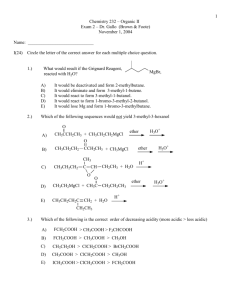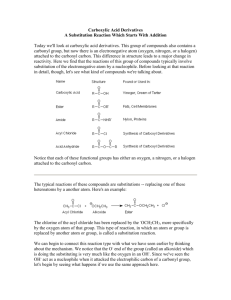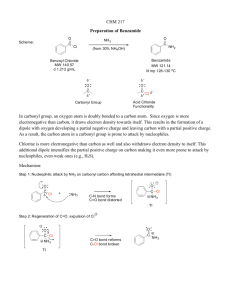1_Addn to carbonylscdx - Master Organic Chemistry
advertisement
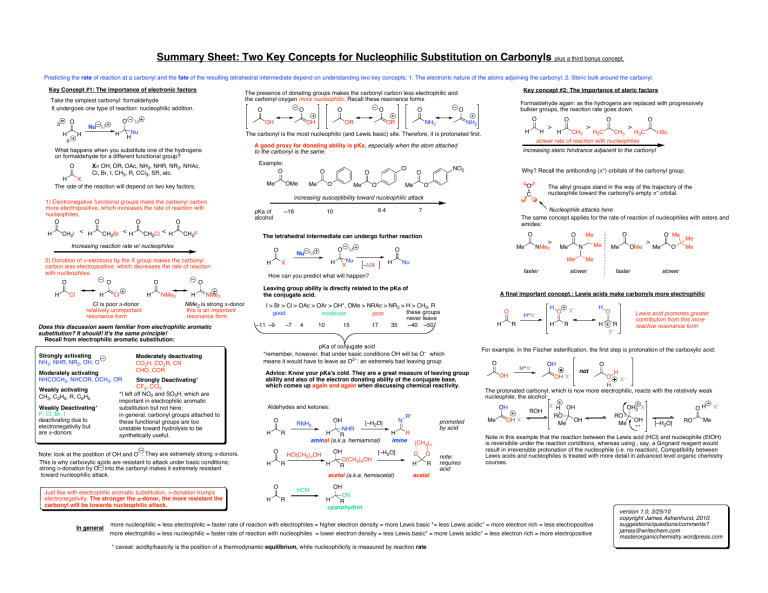
Summary Sheet: Two Key Concepts for Nucleophilic Substitution on Carbonyls plus a third bonus concept. Predicting the rate of reaction at a carbonyl and the fate of the resulting tetrahedral intermediate depend on understanding two key concepts: 1. The electronic nature of the atoms adjoining the carbonyl. 2. Steric bulk around the carbonyl. Key Concept #1: The importance of electronic factors O δ H δ O Nu M O M H < CH2Br H CH2Cl < H CH2F O Cl H H Cl is poor π-donor relatively unimportant resonance form Moderately activating NHCOCH3, NHCOR, OCH3, OR Weakly activating CH3, C2H5, R, C6H5 Weakly Deactivating* F, Cl, Br, I deactivating due to electronegativity but are π-donors NMe2 H NMe2 NMe2 is strong π-donor this is an important resonance form Moderately deactivating CO2H, CO2R, CN CHO, COR Strongly Deactivating* CF3, CCl3 *I left off NO2 and SO3H, which are important in electrophilic aromatic substitution but not here; in general, carbonyl groups attached to these functional groups are too unstable toward hydrolysis to be synthetically useful. Note: look at the postition of OH and O . They are extremely strong π-donors. This is why carboxylic acids are resistant to attack under basic conditions; strong π-donation by O into the carbonyl makes it extremely resistant toward nucleophilic attack. Just like with electrophilic aromatic substitution, π-donation trumps electronegativity. The stronger the π-donor, the more resistant the carbonyl will be towards nucleophilic attack. In general OR Formaldehyde again: as the hydrogens are replaced with progressively bulkier groups, the reaction rate goes down. O NH2 O NH2 H Me Cl O O Me O Me ~16 H O O C Nu M H X Nu X H H3C O > CH3 H3C t-Bu The alkyl groups stand in the way of the trajectory of the nucleophile toward the carbonyl's empty π* orbital. O O > Me O –MX > Nucleophile attacks here The same concept applies for the rate of reaction of nucleophiles with esters and amides: 7 M CH3 Why? Recall the antibonding (π*) orbitals of the carbonyl group. O 9.4 10 O H increasing steric hindrance adjacent to the carbonyl increasing susceptibility toward nucleophilic attack pKa of alcohol > slower rate of reaction with nucleophiles NO2 O O H NMe2 Me faster How can you predict what will happen? Me N Me Nu O Me Me O Me OMe > Me O Me Me Me slower faster slower O Does this discussion seem familiar from electrophilic aromatic substitution? It should! It's the same principle! Recall from electrophilic aromatic substitution: Strongly activating NH2, NHR, NR2, OH, O OMe O O Cl O The tetrahedral intermediate can undergo further reaction 2) Donation of π-electrons by the X group makes the carbonyl carbon less electropositive, which decreases the rate of reaction with nucleophiles. H OR O Me Increasing reaction rate w/ nucleophiles O OH Example: O 1) Electronegative functional groups make the carbonyl carbon more electropositive, which increases the rate of reaction with nucleophiles. O O O O < O A good proxy for donating ability is pKa, especially when the atom attached to the carbonyl is the same. X= OH, OR, OAc, NH2, NHR, NR2, NHAc, O Cl, Br, I, CH3, R, CCl3, SR, etc. H X The rate of the reaction will depend on two key factors. CH2I O The carbonyl is the most nucleophilic (and Lewis basic) site. Therefore, it is protonated first. What happens when you substitute one of the hydrogens on formaldehyde for a different functional group? H O OH Nu H H H Key concept #2: The importance of steric factors The presence of donating groups makes the carbonyl carbon less electrophilic and the carbonyl oxygen more nucleophilic. Recall these resonance forms Take the simplest carbonyl: formaldehyde It undergoes one type of reaction: nucleophilic addition. Leaving group ability is directly related to the pKa of the conjugate acid. A final important concept.: Lewis acids make carbonyls more electrophilic I > Br > Cl > OAc > OAr > OH*, OMe > NRAc > NR2 > H > CH3, R these groups good moderate poor never leave –11 –9 –7 4 10 15 17 35 ~40 ~50 pKa of conjugate acid *remember, however, that under basic conditions OH will be O– which means it would have to leave as O2–: an extremely bad leaving group Advice: Know your pKa's cold. They are a great measure of leaving group ability and also of the electron donating ability of the conjugate base, which comes up again and again when discussing chemical reactivity. H H O H OH [–H2O] NHR H R aminal (a.k.a. hemiaminal) HO(CH2)nOH R H N OH O(CH2)nOH R H HCN R R' H R imine (CH ) 2 n [–H2O] acetal (a.k.a. hemiacetal) O H O O H R promoted by acid note: requires acid H R O Lewis acid promotes greater contribution from this more reactive resonance form R For example, in the Fischer esterification, the first step is protonation of the carboxylic acid: O H+X– OH O not H O X– H The protonated carbonyl, which is now more electrophilic, reacts with the relatively weak nucleophile, the alcohol: OH X– OH OH RNH2 R R H X– O H+X– X– Aldehydes and ketones: O H O Me OH X– ROH X– H RO Me OH OH OH2 X– OH RO Me OH [–H2O] RO X– Me Note in this example that the reaction between the Lewis acid (HCl) and nucleophile (EtOH) is reversibile under the reaction conditions, whereas using , say, a Grignard reagent would result in irreversible protonation of the nucleophile (i.e. no reaction). Compatibility between Lewis acids and nucleophiles is treated with more detail in advanced level organic chemistry courses. acetal OH CN H R cyanohydrin more nucleophilic = less electrophilic = faster rate of reaction with electrophiles = higher electron density = more Lewis basic *= less Lewis acidic* = more electron rich = less electropositive more electrophilic = less nucleophilic = faster rate of reaction with nucleophiles = lower electron density = less Lewis basic* = more Lewis acidic* = less electron rich = more electropositive * caveat: acidity/basicity is the position of a thermodynamic equilibrium, while nucleophilicity is measured by reaction rate version 1.0, 3/25/10 copyright James Ashenhurst, 2010. suggestions/questions/comments? james@writechem.com masterorganicchemistry.wordpress.com

